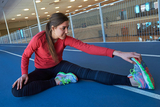
A study published online in Pediatrics confirmed that ACL injuries in children and adolescents are on the rise. From 1994 to 2013, study authors found:
- A 2.3 percent increase annually in the number of ACL tears in patients 6 to 18 years old.
- Females had significantly higher rates of injury in the younger ages.
- Males demonstrated higher incidence in the 17- to 18-year-old age group.
Understanding your risk of suffering an ACL tear is the first step to prevention. At Children’s Hospital of Philadelphia (CHOP), Dr. Theodore Ganley and our sports medicine team are using this data to help counsel patients and families about each individual athlete’s risk of an ACL injury based on their gender and the sports they play. (Review risk factors and symptoms of an ACL tear in children and teens.)
The goal of this information isn’t to scare any athlete from playing or steer you to the sidelines — but to be educated with practical prevention steps you can take to lower your risk of ACL injury.
Featured in this article
Specialties & Programs
A study published online in Pediatrics confirmed that ACL injuries in children and adolescents are on the rise. From 1994 to 2013, study authors found:
- A 2.3 percent increase annually in the number of ACL tears in patients 6 to 18 years old.
- Females had significantly higher rates of injury in the younger ages.
- Males demonstrated higher incidence in the 17- to 18-year-old age group.
Understanding your risk of suffering an ACL tear is the first step to prevention. At Children’s Hospital of Philadelphia (CHOP), Dr. Theodore Ganley and our sports medicine team are using this data to help counsel patients and families about each individual athlete’s risk of an ACL injury based on their gender and the sports they play. (Review risk factors and symptoms of an ACL tear in children and teens.)
The goal of this information isn’t to scare any athlete from playing or steer you to the sidelines — but to be educated with practical prevention steps you can take to lower your risk of ACL injury.
The data supporting this calculator is simplified from the published meta-analysis. See the original published table here. Our numbers are most applicable to the average high school athlete since most of the data came from published incidence rates on this population. Risk may vary based on each athlete’s level of competition, exposures per season, play conditions, age and other individual physical characteristics. For a more personalized risk analysis, we recommend consulting your physician.
How can I lower my risk for an ACL tear?
The primary prevention strategies to avoid ACL injuries are to:
- Avoid overuse and risks associated with participation in multiple sports on multiple teams in the same season. The American Academy of Pediatrics recommends trying a variety of sports, limiting participation in sports to five days a week, and taking a combined two to three months off per year from each specific sport.
- Prepare your knee to better withstand injury-causing behaviors. A prevention program will include specific stretches, warmups, and strength and agility training that prepares the muscles and tendons in the knee for practice and games. These prevention strategies can be implemented as a pre-practice warm up or daily on your own using the Ready, Set, Prevent program.
Updated November 2024
Recommended reading
ACL Injuries

ACL tears are among the most common knee injuries. For serious injuries, surgery may be needed.
Contact us
Sports Medicine and Performance Center